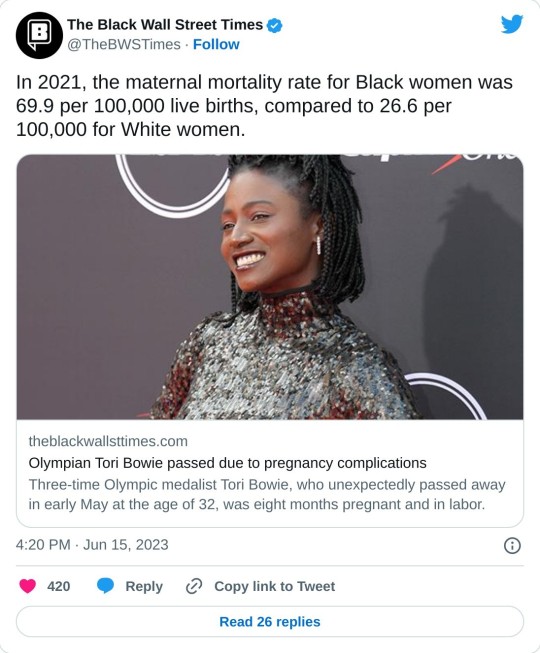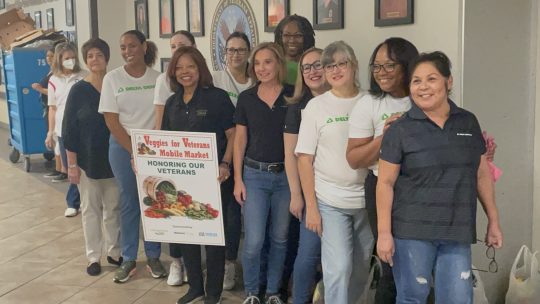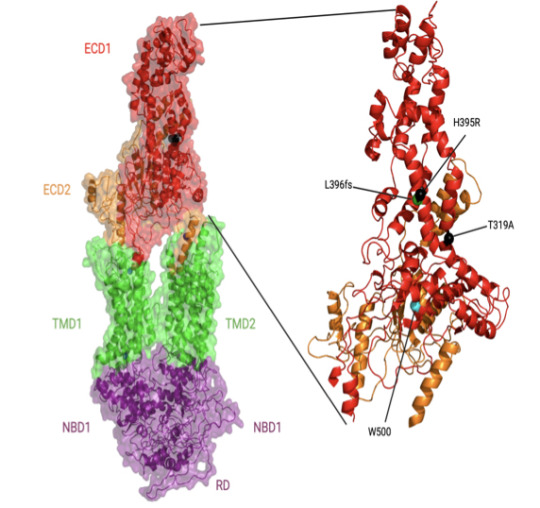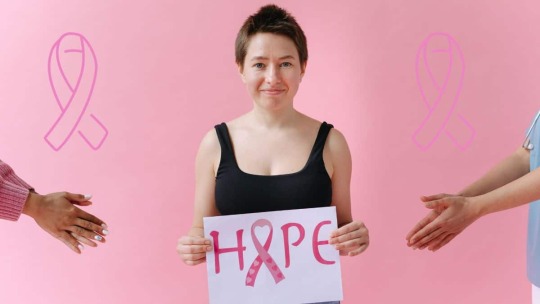#health disparities
Text

#Tori Bowie#Black Mothers Maternal Crisis#Black Mothers#Black Pregnancy#Health disparities#Black Health Matters#Black Lives Matter#Black Babies Matter#Protect Black Women
130 notes
·
View notes
Text
Hey Tumblr! Black women in the US are at a higher risk of dying from pregnancy-related complications. Let's address this issue during Black Maternal Health Week. We can eliminate racial disparities in maternal health by addressing systemic racism and poverty and supporting access to quality healthcare services. Join us in advocating for policy changes and supporting community-based organizations working towards improving maternal health outcomes for Black women.
Black Maternal Health Week: Addressing Racial Disparities in Maternal Health
Maternal health is an essential issue in the United States, and Black Maternal Health Week is a week-long initiative aimed at addressing the racial disparities in maternal health outcomes. The week takes place every year from April 11th to April 17th, and it is an opportunity to raise awareness about the challenges faced by Black women during pregnancy and childbirth.
The Centers for Disease…
View On WordPress
#Black Community#Black Lives Matter#Black Maternal Health Week#Black Moms Matter#Community Support#Health Disparities#Maternal Health#Maternal Mortality#Racial Justice#Reproductive Justice#Support Black Women
8 notes
·
View notes
Text
#fuck american healthcare#us healthcare#fuck health insurance#american health insurance#health insurance#american health system#american healthcare#health wellness#health equity#health rant#health tag#health usa#usa health#health issues#health and wellness#health and safety#health department#health disparities#health facilities#health human#health care#health cw#health concerns#health benefits#health management#health mention#i love polls#polls#tumblr polls#my polls
11 notes
·
View notes
Link
“The Los Angeles City Council voted unanimously on Friday to ban drilling of new oil and gas wells and phase out existing ones over the next 20 years.
The vote comes after more than a decade of complaints from city residents that pollution drifting from wells was affecting their health.
“Hundreds of thousands of Angelenos have had to raise their kids, go to work, prepare their meals (and) go to neighborhood parks in the shadows of oil and gas production,” said Los Angeles City Council president Paul Krekorian, one of the councilmembers who introduced this measure. “The time has come …. when we end oil and gas production in the city of Los Angeles...”
According to the city controller’s office there were 780 active and 287 idle wells within city boundaries in 2018. An idle well is one that is not operating, but neither has it been permanently sealed, so it could be brought back into production...
Researchers from the University of Southern California in a study in 2021 found that people living near wells in two Los Angeles neighborhoods — University Park and Jefferson Park — reported significantly higher rates of wheezing, eye and nose irritation, sore throat and dizziness than neighbors living farther away. Both of those communities are predominantly non-white with large Black and Latino communities, according to the U.S. Census.
The push to ban drilling in the City of Los Angeles is part of a region-wide effort to shut down oil and gas extraction throughout the county of Los Angeles, with similar measures covering Culver City and unincorporated parts of Los Angeles County passed in 2021.
“In Los Angeles, we sit on the largest urban oil deposit in the world,” said councilmember Marqueece Harris-Dawson ahead of the vote. “So if Los Angeles can do it, cities around the world can do it.”” -via PBS News Hour, 12/2/22
#los angeles#los angeles city council#oil and gas drilling#california#pollution#fossil fuels#crude oil#health disparities#environmental racism#good news#hope
23 notes
·
View notes
Text
It would be easy to tell someone who’s emotionally hurting to “just go to therapy”, but not everyone has the privilege of finding a good, affordable therapist who gets them.
Please be mindful of that before you suggest therapy as a catch-all for mental health and healing.
#therapy#healing#recovery#mental health#mental health awareness#mental illness#equity#inequity#health disparities
2 notes
·
View notes
Text
Health inequities are widespread in pediatric medicine, researchers find : Shots - Health News : NPR
0 notes
Text
Veggies for Veterans: Enriching Arizona's Veteran Community
Veggies for Veterans: Providing fresh produce to Arizona's veterans, addressing food access and health disparities in the community.
Veggies for Veterans, a program initiated by Gregory’s Fresh Market, has been making a significant impact on the lives of Arizona veterans. Aa a part of Diana Gregory Outreach Services, the program aims to address food insecurity and health disparities in veteran communities. By providing fresh fruits and vegetables, Veggies for Veterans ensures that no veteran or their family goes to bed…

View On WordPress
0 notes
Text
Structure of Equity - Jamaine Davis - Meharry Medical College
Sharing some of our #SBGrid member tales from the last year. This one from September 2022.
Numbers speak clearly to Jamaine Davis. As a boy growing up on Long Island, math came so easy to him that one of his family nicknames was "the professor."

Other numbers have shaped his ambitions at Meharry Medical College in Nashville, Tennessee, where Davis runs one of the few labs in the world that uses structural biology to help explain biological health disparities.
For example, U.S. Black adults are twice as likely to have Alzheimer's disease compared to non-Hispanic Whites. And despite a somewhat lower overall lifetime risk of breast cancer, Black women experience a 40% higher death rate from breast cancer than White women at every age and are more likely to be diagnosed with fast growing and late-stage breast cancer.
"My research program is basically at the intersection of structural biology, genetics and disease, and health disparities," says Davis of the big-picture questions that guide his lab's work. "What are the molecular mechanisms that dictate who develops diseases like cancer or Alzheimer's? And then how do we design effective therapies? How do we target the right pathways for the right treatment for that patient?"
One project in the early stages focuses on a gene (ABACA7) that has a stronger effect on risk of Alzheimer's disease in Blacks than the better known ApoE4 gene risk variant. "It's actually the strongest risk factor for developing Alzheimer's in African Americans known so far," Davis says.
As he explains it, ABACA7 transports lipids out of cells, handing off the lipids directly to ApoE, and also interacts with Tau, another protein that goes awry in Alzheimer's. Two missense variants in ABACA7 confer the risk.
"So we've been studying these mutations to see what impact they have on lipid transport," Davis says. "Once we're done, we can look at the people who particularly carry this mutation or variant, see what downstream processes are altered, and design therapies to rescue that. And these variants so far have only been identified in African Americans."

In individuals with African ancestry, the phospholipid-transporting ATPase ABCA7 (ABCA7) gene has stronger associations with Alzheimer’s disease risk than in individuals with European ancestry and than the apolipoprotein E (APOE) ɛ4 allele. The Davis lab is exploring the structure and function of key ABACA7 mutations and how they contribute to alterations in transporting lipids, which may influence Alzheimer’s in African Americans. Credit: Courtesy of J.Davis.
Davis began his academic training on a different career path. With his early affinity for math and science, he reasoned that chemical engineering made sense as a college major. But near graduation at Drexel University, he realized that the typical next step for someone with a chemical engineering degree was a job at an oil company. He hadn't taken one biology course in college, but he found himself drawn to biomedical research instead.
He seized an opportunity to work in a biophysics lab at a neighboring school, University of Pennsylvania, where his mentor Jacqueline Tanaka gave him a peek at the scientific career he could have in biophysics and opened his eyes to the kind of academic role model he could be. Her excitement for X-ray crystallography and for increasing the proportion of women and minorities in science inspired him to go to graduate school.
"She built her career in structural biology and mentoring, hand in hand," Davis says. "She saw some potential in me, and I was at a crossroads." Davis had also been unaware of the extent of health inequities across the country and of the low representation of minorities in academia.
For his thesis, Davis chose the lab of Harvey Rubin, a dynamic speaker who fostered an immediate interest in infectious disease. In Rubin's lab, Davis characterized an enzyme that enables Mycobacterium tuberculosis to enter (and possibly exit) the dormancy stage in the lungs of people.
When Davis finished his PhD in 2007, he was the first Black to earn a doctorate in biochemistry and molecular biophysics at UPenn. "I had a great time," he says. "They were very supportive. But it is pretty shocking. If you look at Twitter, there are other people posting the same kind of statistic. They're the first Black to graduate from a certain program at a certain institution. It does show there is still some under-representation across different departments."
He followed up with two postdoctoral fellowships at the National Cancer Institute. He first showed that a novel protein in Shigella (bacteria that cause food poisoning) was not a protease, as some suspected. A second project elucidated the binding modes of a protein with multiple domain repeats implicated in the development of cancer.
Then he thought about how best to combine his interests in a distinctive research program. He chose Meharry, one of the oldest and largest historically black U.S. academic health centers. (Davis is also a member of the Vanderbilt University Center for Structural Biology.)
Historically black colleges and universities are powerhouses in educating African Americans who go on to earn doctoral degrees in science, technology, engineering, math, and medicine, as Davis and his co-authors reviewed in a commentary (Cell, 2022). Blacks make up 12% of the U.S. workforce, but only 5% of working physicians and 3.6% of full-time faculty conducting research at medical schools.
When the COVID-19 pandemic hit, Davis found new opportunities for mentorship and community outreach. Soon after the pandemic took hold, a student-driven community formed on Twitter with the handle @BlackInBiophys and a logo designed by Taneisha Gillyard, a former postdoc in the Davis lab. Davis spoke at a virtual meeting held by the group.

A former postdoc in the Davis lab, Taneisha Gillyard, designed the logo for @BlackInBiophys, a student-driven community that formed on Twitter during the pandemic. Credit: Taneisha Gillyard.
In a short time, a strong sense of community developed among people who may have never met in person, but know a lot more about each other through social media, Davis says. People share grant writing tips, training and job opportunities, and generally celebrate the scientists, their contributions, and career options for the next generation.
The visibility may help change other statistics about Black researchers receiving less NIH funding and being cited less often than their white colleagues, Davis says.
Davis also teamed up with Meharry colleague Jennifer Cunningham-Erves to develop a funded community outreach project to address community concerns about vaccines. He has spoken about the basic science of mRNA at townhall-style community meetings, in person and virtual. The online recordings have reached people from Chicago to New York to Haiti.
The project collaborates with a consortium of more than 90 churches in middle Tennessee and Better Options TN, a community nonprofit organization. To understand concerns, the Meharry team interviewed people in the Southern United States. They developed and organized content on a frequently updated web site, https://yourcovidvaxfacts.com/en.
"We asked about their thoughts about the vaccine and the virus," Davis says. "The biggest one, particularly for Black Americans, was the distrust with government and healthcare. But I was very impressed with some of the questions that the public had. They weren't getting answers, and they wanted answers. If you remember, one of the major issues with people not getting a vaccine was that they thought it would affect their DNA. They just weren't familiar with mRNA."
Davis felt their concerns and trust issues as well. He initially was cautious about being vaccinated himself, waiting to see more data about its safety in people. "Even being a scientist, I was hesitant," he says. "I didn't want to be one of the first," he says. But as he explained the science and helped alleviate concerns of others, he also convinced himself to get the vaccine too.
Meanwhile, back in the lab after the pandemic disruptions, Davis and his team are working to improve health outcomes for populations most at risk, one variant protein and pathway at a time.
- Carol Cruzon Morton
0 notes
Text
Improve access to quality care for all by using innovative care guidance strategies to tackle healthcare inequities. Empower your organization with effective solutions promoting inclusive healthcare experiences. Boost patient satisfaction with informed decisions!
0 notes
Text
0 notes
Text
Unveiling the Truth: Breast Cancer Overdiagnosis Among Women Over
Understanding Breast Cancer Overdiagnosis: A Comprehensive Insight
Breast cancer stands as a significant concern for women across all age groups, with increased prominence as women reach their 70s and beyond. Recent years have witnessed mounting evidence of breast cancer overdiagnosis within this demographic, sparking critical debates about the efficacy and appropriateness of screening…

View On WordPress
#Age-specific screening#Breast cancer overdiagnosis#Cancer awareness#Elderly breast health#Health disparities#Healthcare decisions#Medical interventions#Screening guidelines#Shared decision-making#Women over 70
0 notes
Text
Health Disparities
EARLY DEATH IS A GREATER RISK FOR BLACK PEOPLE (than white individuals) in the United States. New research points to social disparities as the primary culprits. Today we look at social determinants — eight keys for extending lives and closing health disparities in America.
Lengthening Black (and other) American lives requires addressing various social, economic, and healthcare disparities…

View On WordPress
0 notes
Text

1 note
·
View note
Text
#health#Healthline#health equity#health disparities#African Americans#heart disease#obesity#diabetes#high blood pressure#stroke#sickle cell disease#cancer#kidney disease#asthma#hiv/aids#covid#culturally competent care
0 notes
Text

0 notes
Text
Lupine Publishers | Most Challenging Urologic Complaint of Men Ever After- Short Penile Length: What is the Situation in Turkish Men
Abstract
Introduction & Objectives: Short penile length is probably the oldest symptom of men for centuries. It can be troubling enough for many men although not short in fact. Urologists often meet cases attending with complaints of insufficient penile length, but it is known that the measures of penile length are normal in majority of cases. It is known that nearly all of the cases do not have any knowledge in terms of normal penile length. In the literature, many studies have dealt with measures of penile length in flaccid position. In order to build up a nomogram of the population, erectile penile length and penile circumference should be measured.
Material & Methods: In this study, cases attending with complaints of insufficient penile length and/or penile curvature were evaluated retrospectively via results of self-measurement of erectile penile length by photographs taken by the patients at home and circumference and its photographic documentation by patients. 1470 cases, aged between 19-73, attended outpatient urology clinic between March 2010 and April 2019 with complaints of short penile length and/or penile curvature. They were evaluated with IIEF scores (International Index of Erectile Function), all of whom scored between 36 and 70, measurement of serum total testosterone, BMI (body mass index) values and the outcomes of self-measurement of penile length and circumference and its documentation by the patients. The patients were told to measure the erectile length of penile shaft with a ruler from the skin of penile root to the glans penis and the erectile penile circumference with a tape measure around the root of the penis while alone and they were asked to document this process via a photograph taken at home alone and bring it to the clinic in the control visit.
Results: None of the patients had any penile curvature in erectile form in documentations and they were told not having any problem of this kind. The mean BMI of cases was 23,3±2,9 and the erectile penile length was14,10±1,58cm with penile circumference being 11,24±1,51cm. The cases were found to show correlation between measurements of erectile penile length and penile circumference.
Conclusion: The penile length of 14,10±1,58cm in this study is greater than the dimensions, defined in the literature. This study can be used to define normal erectile penile length and penile circumference in this population and to compare the attending cases. Knowing to have a normal erectile penile length will re-establish their courage. All these efforts are worth to try after seeing the patients, pleased with themselves upon learning that they are not “short” in fact.
Read more about articles: https://lupinepublishers.com/clinical-community-medicine/fulltext/most-challenging-urologic-complaint-of-men-ever-after-short-penile-length.ID.000108.php
Read more about Lupine Publishers Google Scholar articles: https://scholar.google.com/citations?view_op=view_citation&hl=en&user=vfbCW-wAAAAJ&cstart=20&pagesize=80&citation_for_view=vfbCW-wAAAAJ:kz9GbA2Ns4gC
#health disparities#mental health education#Lupine Publishers LLC#Lupine Publishers Group#Lupine publishers
0 notes